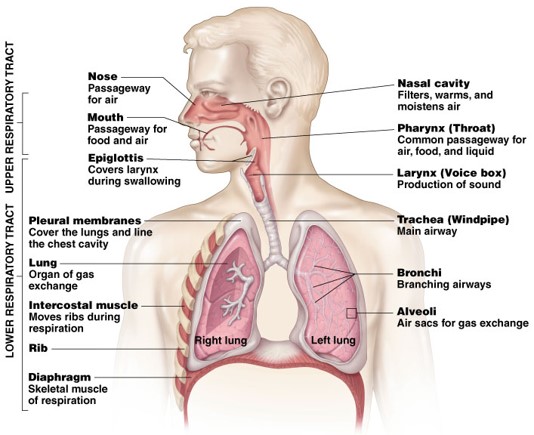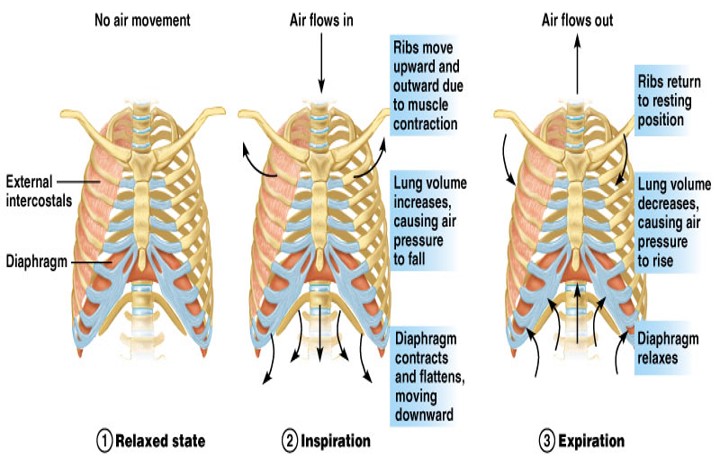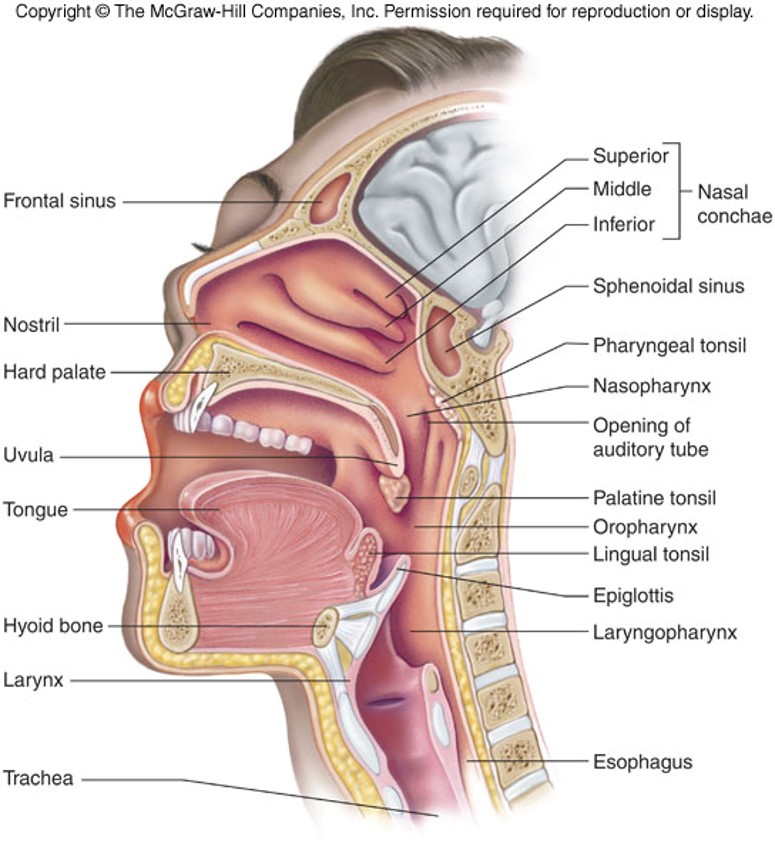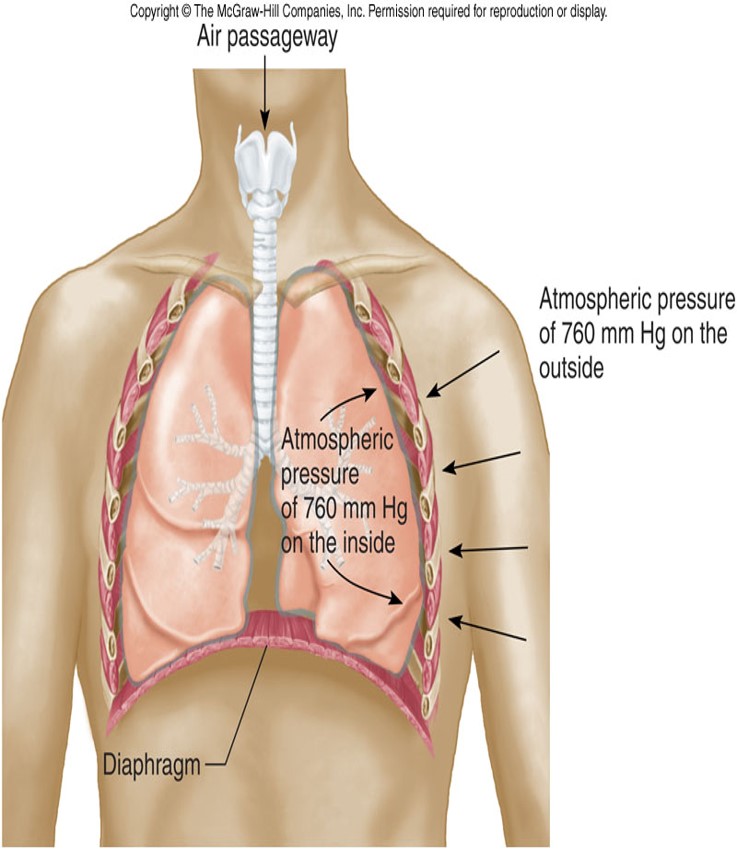RESPIRATORY SYSTEM
The Anatomy and Physiology of the Respiratory System
WHAT IS HUMAN RESPIRATION?
Human respiratory system allows one to obtain oxygen, eliminate carbon dioxide
Breathing consists of two phase
- Inspiration - the process of taking in air
- Expiration - the process of blowing out air



Upper respiratory tract function
Passageway for respiration
Receptors for smell
Filters incoming air to filter larger foreign material
Moistens and warms incoming air
Resonating chamber for voice

Lower respiratory tract functions
Larynx - maintains an open airway, routes food and air appropriately, assists in sound production
Trachea - transports air to and from lungs
Bronchi - branch into lungs
Lungs - transport air to alveoli for gas exchange




FOUR RESPIRATION PROCESS
- Breathing (ventilation) - air into and out of lungs
- External respiration - gas exchange between air and blood
- Internal respiration - gas exchange between blood and tissues
- Cellular respiration - oxygen use to produce ATP, carbon dioxide as waste
Functions of the Respiratory System
- Air Distributor
- Gas exchanger
- Filters, warms, and humidifies air
- Influences speech
- Allows for sense of smell
Divisions of the Respiratory System
Upper respiratory tract (outside thorax)
Nose
Nasal Cavity
Sinuses
Pharynx Larynx

Divisions of the Respiratory System
Lower respiratory tract (within thorax)
Trachea
Bronchial Tree
Lungs

Structures of the Upper Respiratory Tract
Nose - warms and moistens air
- Palatine bone separates nasal cavity from mouth
- Cleft palate - Palatine bone does not form correctly, difficulty in swallowing and speaking.
- Septum - separates right and left nostrils
- rich blood supply = nose bleeds
- Sinuses - 4 air containing spaces – open or drain into nose - (lowers weight of skull).
Pharynx (throat)
Base of skull to esophagus
3 divisions
Nasopharynx - behind nose to soft palate.
- Adenoids swell and block.
Oropharynx - behind mouth, soft palate to hyoid bone.
- tonsils
Laryngopharynx - hyoid bone to esophagus.
• Changes shape to allow for vowel sounds = phonation.
Larynx
voice box
Root of tongue to upper end of trachea.
Made of cartilage
2 pairs of folds
• Vestibular - false vocal cords
• True vocal cords

Thyroid cartilage
- Adam’s apple
- larger in males due to testosterone.
Epiglottis
- flap of skin (hatch) on trachea, moves when swallowing and speaking and closes off trachea when swallowing food
Trachea (windpipe)
Larynx to bronchi
Consists of smooth cartilage and C shaped rings of cartilage.
Tracheostomy - cutting of an opening in trachea to allow breathing.
 Bronchi
BronchiTubes that branch off trachea and enter into lungs
Ciliated– WHY?
Branches: Primary bronchi — secondary bronchi — tertiary bronchi — bronchioles – Bronchioles branch into microscopic alveolar ducts. Terminate into alveolar sacs – Gas exchange with blood occurs in sacs.
 Lungs
LungsExtend from diaphragm to clavicles
Divided into lobes by fissures.
Visceral pleura adheres to the lungs
Pleurisy = inflammation of the pleural lining (Plural – bronchi)

Respiratory Physiology
Pulmonary Ventilation = breathing
Mechanism
- Movement of gases through a pressure gradient - hi to low.
Inspiration - When atmospheric pressure (760 mmHg) is greater than lung pressure ---- air flows in
Expiration - When lung pressure is greater than atmospheric pressure ---- air flows out

Pressure gradients are established by changes in thoracic cavity.
increase size in thorax = a decrease in pressure --- air moves in.
Decrease size in thorax = increase in pressure --- air moves out.


Inspiration - contraction of diaphragm and intercostal muscles

Expiration - relaxation of diaphragm and intercostal muscles
 Volumes of Air Exchange
Volumes of Air Exchange
• Tidal volume
- amount of air exhaled normally after a typical inspiration. (about 500 ml)
• Expiratory Reserve volume
- additional amount of air forcibly expired after tidal expiration (1000 - 1200 ml).
• Inspiratory Reserve volume
- (deep breath) amount of air that can be forcibly inhaled over and above normal.
• Residual volume
- amount of air that stays trapped in the alveoli (about 1.2 liters).
• Vital capacity
- the largest volume of air an individual can move in and out of the lungs.
• Vital capacity = sum of IRV+TV+ERV
Depends of many factors
• size of thoracic cavity
• posture
• volume of blood in lungs
- congestive heart failure, emphysema, disease, etc.
• Eupnea
- normal quiet breathing, 12-17 breaths per minute.
• Hyperpnea
- increase in breathing to meet an increased demand by body for oxygen.
• Hyperventilation
- increase in pulmonary ventilation in excess of the need for oxygen.
Someone hysterical (exertion) → Breathe into paper bag.
• Hypoventilation - decrease in pulmonary ventilation.
• Apnea - temporary cessation of breathing at the end of normal expiration.
Heimlich Maneuver
Lifesaving technique that is used to open a windpipe that is suddenly obstructed.
Air already in lungs used to expel object.

Technique - Conscious victim
– Ask the victim if he/she can talk
– Stand behind victim and wrap your arms around their waist
– Make a fist with one hand and grasp it with the other hand
– Place thumb side of fist below xiphoid process and above navel.
– Thrust your fist in and upward - about 4 times.
- DO NOT press on ribs or sternum
Technique - Unconscious victim
• Catch victim if they begin to fall - place on floor face up.
• Straddle hips
• Place one hand on top of other on the victims abdomen - above navel and below xiphoid process.
• Forceful upward thrusts with heel of hand - several times if necessary.